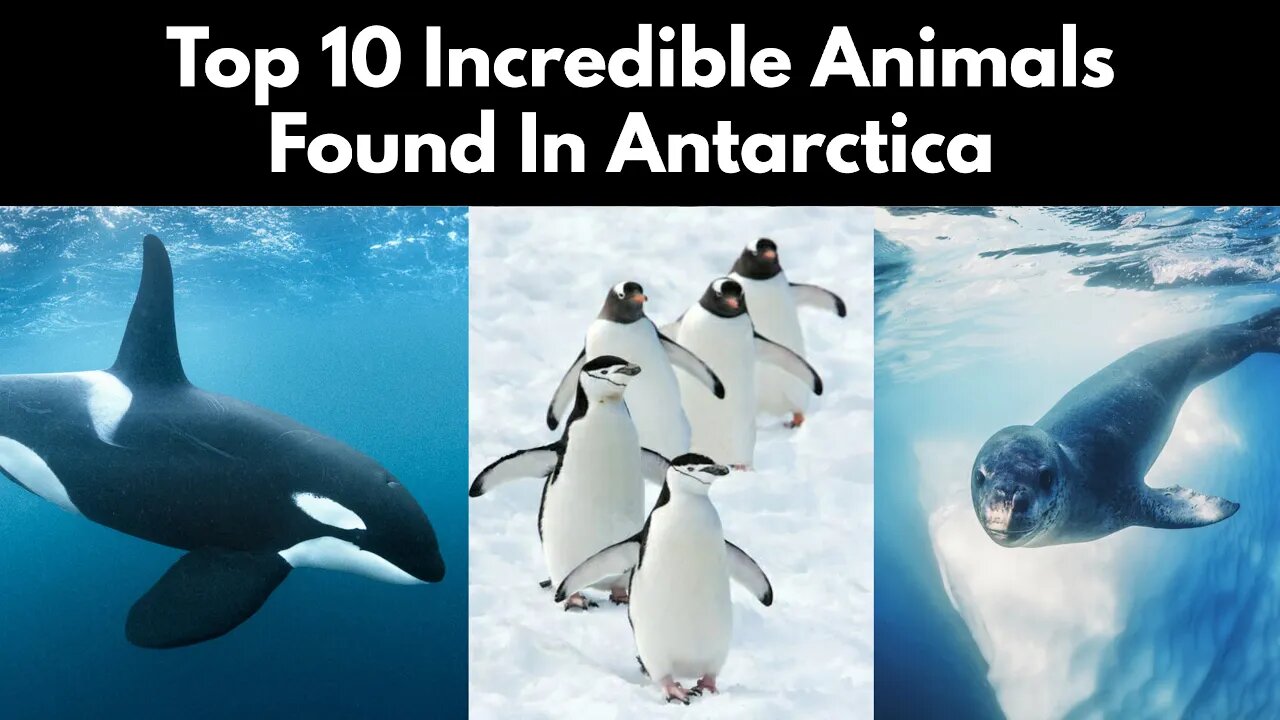Premium Only Content

Top 10 Incredible Animals Found In Antarctica
Here are 10 of the most Beautiful and Incredible Animals found in Antarctica
From Cute Penguins to Massive Killer Whales, These are the most magnificent in the whole of Antarctica!
Antarctica have a wide range of incredible animals including Killer whale, Chinstrap penguins, Blue whale, Leopard seal etc.
We hope you found this video on Antarctic animals useful,
Do subscribe for more :)
In this video we speak about animals found in Antarctica that we have found to really interesting and magnificent in their own ways
Photos used -
Also known as orcas, killer whales are one of the most widely recognized species in Antarctica. Found in oceans around the world, these whales are uniquely suited to the icy Antarctic waters and have a layer of blubber that helps them maintain their body heat while diving to depths over 325 feet.
These beautiful animals also stay warm by traveling in pods and can swim up to 30 miles per hour thanks to their hydrodynamic structure, dorsal fin, and pectoral flippers. Echolocation enables them to communicate with one another and find food.
Emperor penguins are the largest penguins and among the most charismatic because of their unique breeding habits. After laying a single egg, the female passes it to her mate for incubation and goes out looking for food — sometimes traveling 50 miles to the ocean. During this time, the male fasts for more than 100 days while incubating their egg and awaiting the female’s return.
In the water, emperor penguins can dive up to 1,850 feet (the deepest of any bird), and can stay underwater for longer than 20 minutes.
The Elephant seal is the largest of all seals in Antarctica. Male elephant seals can range anywhere from 1,500 kg to 3,700kg, whilst females are considerably smaller, ranging between 600kg to 800kg. This huge difference in size between the sexes is called sexual dimorphism and it is so prevalent that sometimes females are mistaken for juveniles. You can find elephant seals throughout the Antarctic region – particularly on sub-Antarctic islands, and they are sometimes found as far north as the Falkland Islands.
The antarctic krill has a population density around 280 to 850 krill per cubic foot, making it one of the most abundant species on Earth and an important source of food for larger animals in Antarctica.
Like penguins and other animals that live in Antarctica, leopard seals have thick blubber to retain body heat. Their bodies are also streamlined and extremely muscular, which helps them swim up to 24 miles per hour and dive up to depths around 250 feet to capture their prey — often krill, fish, penguins, and, sometimes, other seals.
What’s more, leopard seals have nostrils that can be closed to keep water out when they’re diving. Other helpful adaptations include large eyes to maximize light intake underwater and whiskers that help them sense movement when hunting.
The snow petrel is one of the Antarctic's smallest, yet most beautiful, animals. They are pure white in colour – apart from their black eyes and beak. They are about the same size as a pigeon but they are fascinating because, even though they are so small, they are mighty and manage to survive the extreme Antarctic conditions and wind-chill.
Chinstrap Penguin - Growing to only about 30 inches in length, chinstrap penguins are small but mighty. Not only are they the most aggressive penguins, chinstraps typically swim up to 50 miles off the shore to feed on krill, as well as some fish, shrimp, and squid.
The wandering albatross is a large bird with a remarkable 11-foot wingspan. Their huge size lets them glide for hours without the need to land or, in some cases, flap their wings. The birds have also adapted to life in Antarctica with their ability to drink seawater and excrete excess salt from their body from tubes along the side of their beaks. The wandering albatross’s unique beak structure features nostrils that help them smell prey from miles away. Their nostrils also close to prevent water from entering while they swim and dive.
The blue whale is the largest and loudest animal ever known to have existed. On average, they are around 30 metres long and they weight around 200 tonnes. Their calls are louder than a jet engine and their heart is the size of a small car. Although not exclusive to Antarctica, the blue whale is so impressive that it had to on our list.
Arctic terns are medium-sized birds that migrate from the Arctic to the Antarctic. Traveling around 25,000 miles every year, they spend winters — or southern summers — in Antarctica. The birds can live between 15 and 30 years, and, like snow petrels, can grow up to about 15 inches in size.
-
 37:59
37:59
Esports Awards
17 hours agoMartin Irlicht on Managing Superstar Influencers, Protecting Creators & Latest Trends | Origins #5
22 -
 2:55:46
2:55:46
TimcastIRL
11 hours agoTrump THREATENS To SUSPEND Habeas Corpus To BYPASS Judges Blocking Deportation | Timcast IRL
369K231 -
 2:29:18
2:29:18
Laura Loomer
10 hours agoEP119: Trump's First 100 Days: Were Promises Kept?
93.8K37 -
 57:01
57:01
Man in America
14 hours ago🚨 RED ALERT: Miscarriages & Infertility Are SKYROCKETING—OBGYN Warns of Population Collapse
50.7K84 -
 23:33
23:33
Friday Beers
12 hours ago $20.18 earnedTensions Explode During Wild West Mafia Game!
91.6K10 -
 1:22:39
1:22:39
Badlands Media
1 day agoAltered State S.3, Ep. 26
81.7K19 -
 5:42:28
5:42:28
JdaDelete
14 hours ago $10.82 earnedBanjo-Kazooie - wedNESday
75.8K6 -
 30:09
30:09
Iggy Azalea
15 hours ago $7.82 earnedplaying motherland
83.9K45 -
 8:00:03
8:00:03
SpartakusLIVE
12 hours agoDuos w/ Rallied || A Spartan and a Dragon ENTERTAIN the MASSES
78.6K5 -
 20:09
20:09
Exploring With Nug
20 hours ago $3.13 earnedVanished After Driving Away… I Spent the Day Searching Lakes
76.2K13